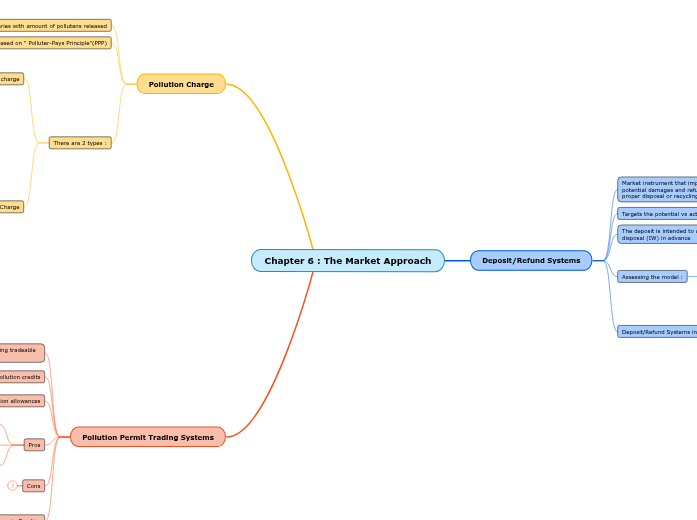Chapter 6 : The Market Approach
Deposit/Refund Systems
Market instrument that imposes an up-front charge to pay for potential damages and refunds it for returning a product for proper disposal or recycling
Targets the potential vs actual polluter
The deposit is intended to capture the MEC of improper waste disposal (IW) in advance
Assessing the model :
Pros
Promotes responsible behaviour
Requires minimal supervision by government
Help slow the use of virgin raw materials by improving availability of recycled materials
Deposit/Refund Systems in Parctice
Are used worldwide
Other applications include systems used to promote responsible disposal of used tires,old cars and batteries
Pollution Charge
Fee that varies with amount of pollutans released
Based on " Polluter-Pays Principle"(PPP)
There are 2 types :
Product charge
Fee added to price of pollution-generating product,which generates negative externality
Impose product charge as per unit tax on product
Emission/Effluent Charge
A fee imposed directly on the discharge of pollution
Typically implemented through a tax
2 models to be analyzed:
Single polluter model
Multiple polluter model
Pros
Cost-effective solution is obtained
MACs are equal
Abatement statement is met
Cons
Tax authority will not know where MACs are equal
Monitoring costs potentially higher
Firms might evade tax by illegally disposing pollutants
Effluent charge in practice
Some countries use effluent charges to control the noise pollution generated by aircraft
London city imposes toxicity charge (T-charge) in certain zones on the usage of old cars
Pollution Permit Trading Systems
Establishes a market for rights to pollute by issuing tradeable pollution credits or allowances
Pollution credits
These are tradeable permits issued for emitting below an established abatement standard
Pollution allowances
These are tradeable permits that indicated the maximum level of pollution that may be released
Pros
It is cost effective as MACs become equal for all firms
Trading establishes the price of a right to pollute without government trying to search for a price
Trading system is flexible
Cons
Pollution Trading Systems in Practice
Trading of greenhouse gas allowances are part of Kyoto Protocol
US has an allowance-based trading program to control sulfur dioxide emissions
